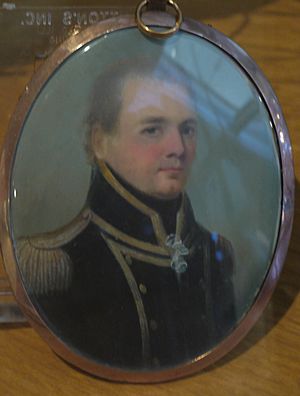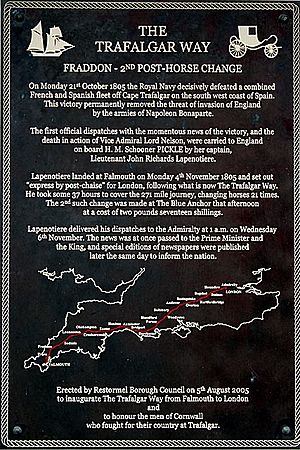John Richards Lapenotière facts for kids
Quick facts for kids
John Richards Lapenotière
|
|
|---|---|

A Miniature believed to depict John Richards Lapenotière
|
|
| Born | 1770 Ilfracombe, Devon, England |
| Died | 19 January 1834 Roseland, near Menheniot, Cornwall |
| Allegiance | |
| Service/ |
|
| Years of service | 1780 - 1811 |
| Rank | Post Captain |
| Battles/wars | Battle of Trafalgar, 1805 Battle of Copenhagen, 1807 |
Captain John Richards Lapenotière (1770 – 19 January 1834) was a brave officer in the Royal Navy. He became famous for carrying the news of a huge victory and a sad loss. In 1805, he commanded a small ship called HMS Pickle. He saw the famous Battle of Trafalgar and helped rescue sailors afterward. Then, he raced across Britain to deliver the news that the British had won, but Admiral Nelson had died.
Contents
John Richards Lapenotière was born in 1770 in Ilfracombe, Devon, England. His family had come to Britain from France in 1688. They were Huguenots, a group of French Protestants who faced persecution. His great-grandfather was also a soldier. He fought in big wars like the War of the Spanish Succession.
John followed his father into the navy when he was very young. He joined his father's ship when he was just ten years old. This was not official, but it gave him an early start.
Learning to Sail
At fifteen, John joined a trading trip to what is now Alaska. This was a wild and difficult coast back then. On this trip, he learned how to sail small ships in tough weather. This experience helped him a lot later in his career. He spent most of his time commanding smaller vessels.
After some time as a midshipman in the Royal Navy, John took a break. He joined another expedition with William Bligh. This trip was to the South Pacific to collect breadfruit plants. These were needed to replace plants lost after the famous Mutiny on the Bounty.
A Career at Sea
John returned to the navy just in time for the French Revolutionary War. He traveled to the West Indies with a fleet led by John Jervis. John was briefly made a lieutenant on HMS Boyne. His great sailing skills soon earned him command of a small ship, the schooner HMS Berbice.
In 1796, he moved to the frigate HMS Resource. Over the next few years, he served on several other ships. By 1800, he was given command of a small cutter called Joseph. In Joseph, he showed his bravery in small boat battles along the French coast. This was before a period of peace called the Peace of Amiens. During this peaceful time, he married Lucia Shean and they had three daughters.
Commanding HMS Pickle
John's hard work was noticed. In 1802, he was given command of the 10-gun schooner HMS Pickle. He continued to patrol the French coast in this ship. In 1804, he was praised for saving the crew of a large warship, HMS Magnificent. This ship had crashed off Ushant.
During this time, John's first wife passed away. He soon remarried Mary Anne Graves. They had seven more children together. Two of his sons later became naval officers too. His ship, Pickle, then joined Admiral Nelson's fleet. They were blocking the port of Cadiz in Spain. Pickle helped the fleet by capturing ships carrying food. This helped feed the many sailors.
The Battle of Trafalgar News
Pickle was too small to fight in the huge Battle of Trafalgar. This battle happened on October 21, 1805. But Pickle's help was very important after the battle. A big storm hit, making conditions very dangerous. Lapenotière's ship worked hard to rescue survivors from the water. They also took men off sinking ships for a whole week. They even tried to tow damaged ships to save them from the waves.
On October 26, Admiral Collingwood chose Pickle for a special mission. He sent Lapenotière to Britain with the official news of the great victory. This was a huge honor for a junior officer. It almost guaranteed a promotion and fame. Some other officers were a bit jealous of this choice.
The Trafalgar Way Journey

Pickle reached the English Channel on November 1. The wind was too strong for Lapenotière to sail further up the Channel. So, he landed at Falmouth. From there, he began a very long and tiring journey overland to London. He used a series of mail coaches and fresh horses.
He arrived in London on November 6. The journey was about 271 miles long. It took him 37 hours and he changed horses 21 times. He delivered his important messages to William Marsden, a high-ranking official. Lapenotière famously said, "Sir, we have gained a great victory. But we have lost Lord Nelson."
Rewards and Later Service
As expected, Lapenotière was greatly rewarded for his amazing effort. He was promoted to the rank of Commander. He also received a special sword and £500 in cash. King George III even gave him a silver spice sprinkler. This item is now owned by the mayor's office in Liskeard.
He was then given command of the 16-gun Orestes. In 1807, he took part in the bombardment of Copenhagen. During this battle, he was badly wounded by an exploding gun.
For the next four years, he sailed Orestes out of Plymouth. With Orestes, he captured two privateers (enemy ships allowed to attack others) and a rich American merchant ship.
In 1811, he was promoted to Post Captain. However, he could not get another ship to command. He spent the rest of the war working on shore duties. He never commanded a ship at sea again. John Lapenotière settled down with his family in Menheniot, Cornwall. He passed away peacefully in 1834 and was buried next to his second wife.
See Also


